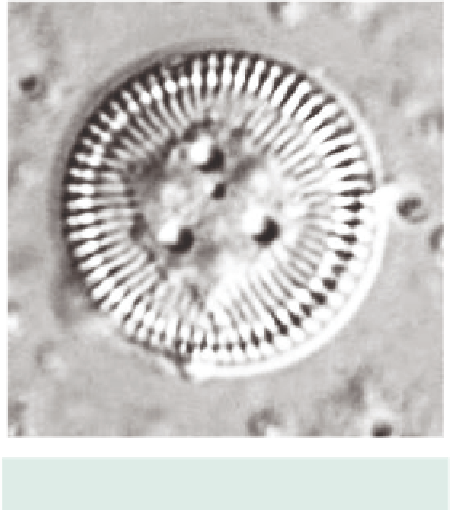Environmental Engineering Reference
In-Depth Information
with only one British freshwater species,
C. lacustris.
Bacillariophyta. Plate XXI.
139
(127) (a) Valves with at least one long spine.
The spines are as long as, or are longer
than, the cell ......................
140
(b) Valves without long spines . .....
144
140
(139) (a) Cells (many times as long as wide)
forming a typical filament, with one long
spinevisibleattheend.................
Aulacoseira granulata v. angustissima
(see also key No. 27)
5 μm
(b) Cellsnotasabove..............
141
141
(140) (a) Cells with two long spines per cell,
one at each end . ...................
142
Figure 4.62
Cyclotella
. Valve view of diatom, with
clear separation of central and peripheral areas. Acid
digest, lake sediment sample. Reproduced with permis-
sion from M. Capstick.
(b) Cells with four long spines per cell,
two at each end . ...................
143
lying parallel to the main radial ones. Cells
(20-170 μm diameter) contain numer-
ous plate-like chloroplasts. Common in
coastal and estuarine plankton and as an
epiphyte. Bacillariophyta. Plate XIX.
142
(141) (a) Cells long and thin, up to 200 μm ×
10 μm. Spines arise from the centre of the
valveend.................
Rhizosolenia
Rhizosolenia
cells may be solitary or
may form chains. Numerous small plate-
like/disc-shaped chloroplasts. Frustule
wall only lightly silicified so can be over-
looked especially in acid cleaned speci-
mens when the frustule components often
disintegrate. Planktonic in lakes and slow
flowing rivers. Bacillariophyta. Plate XX.
(b) Valve surface gently undulate. Coarse
punctate markings over surface forming
radial rows or arcs. Punctae circular or
hexagonal. ..............
Coscinodiscus
The valve markings on
Coscinodiscus
are
generally coarse and often hexagonal in
shape although not always so. They cover
the whole valve face except for a small
central hyaline area which may be present
together with a rosette of larger punctae
(these may be present without the hyaline
area). The valve margin may have small
spines although these are seldom visible
under a light microscope. Cells (up to
300 μm diameter) contain numerous plate-
like chloroplasts. Free-floating and abun-
dant in the plankton. Mostly salt water
(b) Cells long, but not as long as above,
150 × 20 μm. Spines arise from opposite
corners....................
Urosolenia
Cells are most frequently solitary with
many disc-shaped chloroplasts. A plank-
tonic species in usually large and deep
lakes which are enriched and of a
slightly alkaline nature. Bacillariophyta.
Plate XX.

Search WWH ::

Custom Search